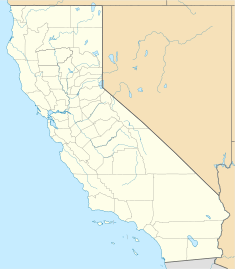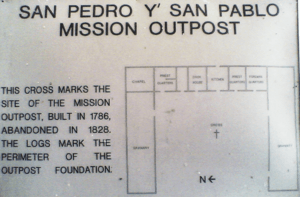San Pedro y San Pablo Asistencia facts for kids

The perimeter of the outpost's foundation is outlined with logs.
|
|
| Location | Pacifica, California |
|---|---|
| Coordinates | 37°35′14″N 122°29′36″W / 37.58722°N 122.49333°W |
| Name as founded | Asistencia de la Misión San Francisco de Asís |
| English translation | Sub-Mission of the Mission San Francisco de Asís |
| Patron | Saint Peter and Saint Paul |
| Founding date | 1786 |
| Military district | Fourth |
| Native tribe(s) Spanish name(s) |
Ohlone Costanoan |
| Native place name(s) | Pruristac |
| Governing body | County of San Mateo |
| Current use | Museum |
| Designated | 1976 |
| Part of | Sánchez Adobe |
| Reference no. | #NPS–76000525 |
| Designated | 1947 |
| Part of | Sánchez Adobe |
| Reference no. | #391 |
The San Pedro y San Pablo Asistencia was a special kind of "sub-mission" or branch outpost. It supported the main Mission San Francisco de Asís. This historic site is located in the San Pedro Valley in Pacifica, California.
It was started in 1786 in an Ohlone village called Pruristac. Today, the area is part of the Rancho San Pedro, which is home to the famous Sánchez Adobe.
Contents
History of the Asistencia
When the San Pedro y San Pablo Asistencia was first built, it grew quickly.
Early Buildings and Crops
- In the first year, workers built a chapel, a granary (for storing grain), a tack room (for horse gear), and three other rooms. Native people helped with all this construction.
- By 1788, two more rooms were added.
- In 1789, a second granary was built. They also added living spaces for the mayordomo (the person in charge) and for the missionaries.
- A covered hallway was also built, which was used as a kitchen for a while.
The people at the Asistencia grew many different crops. They planted wheat and beans. Later, they also grew corn, peas, barley, asparagus, and rosemary. They even had vineyards for grapes and groves of peach and quince trees.
Limestone was dug up from nearby Mori Point. This limestone was used for building and other needs at the main mission. At its busiest time, the Asistencia had a main building with three wings around a central open area.
Changes Over Time
Sadly, the number of native people living at the Asistencia dropped a lot. Many became sick, and the population went from 300 in 1790 to just 25 by 1792. Because of this, the Asistencia was closed down. After 1790, it was mostly used as a place to let cattle graze.
After the Missions Closed
In 1834, the Mexican government decided to close down the missions. This was called the secularization of the missions.
- In 1839, Juan Bautista Alvarado, who was the Mexican Governor of California, gave the lands of the Rancho San Pedro to Francisco Sanchez. This land was about 8,926-acre (36.12 km2) and included all the buildings of the Asistencia.
- Francisco Sanchez kept his land even after California became part of the United States in 1848.
- Later, in 1894, roof tiles from the old Asistencia buildings were taken and used. They were put on the Southern Pacific Railroad station in Burlingame, California. This train station was one of the first buildings designed in the Mission Revival Style, which copied the look of old Spanish missions.
Today, not much is left of the original San Pedro y San Pablo Asistencia.




